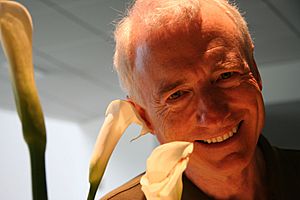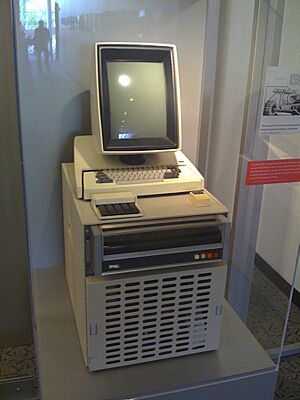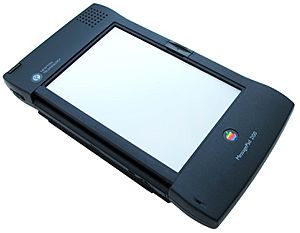Larry Tesler facts for kids
Quick facts for kids
Larry Tesler
|
|
|---|---|

Tesler in 2005
|
|
| Born |
Lawrence Gordon Tesler
April 24, 1945 The Bronx, New York City, U.S.
|
| Died | February 16, 2020 (aged 74) Portola Valley, California, U.S.
|
| Citizenship | American |
| Alma mater | Stanford University |
| Known for | Copy and paste |
| Spouse(s) |
Shelagh Leuterio
(m. 1964; div. 1969)Colleen Barton
(m. 1970) |
| Children | 1 |
| Scientific career | |
| Fields | Human–computer interaction |
| Institutions | Xerox PARC, Apple, Amazon, and Yahoo! |
Lawrence Gordon Tesler (born April 24, 1945 – died February 16, 2020) was an American computer scientist. He helped make computers easier for people to use. This field is called human–computer interaction.
Tesler worked at famous companies like Xerox PARC, Apple, Amazon, and Yahoo!. At Xerox PARC, he helped create Smalltalk, an important programming language. He also worked on Gypsy, one of the first word processors with a graphical user interface (GUI). A GUI uses pictures and menus, not just text, to help you use a computer.
With his friend Tim Mott, he invented the "copy and paste" feature we all use today! He also came up with the idea of "modeless" software. This means you can do anything in a program without changing special "modes." Later at Apple, he worked on the Apple Lisa and the Apple Newton. He also helped create Object Pascal, a programming language used to build computer programs.
Contents
Larry Tesler's Early Life
Larry Tesler was born on April 24, 1945, in The Bronx, New York City. His parents were Isidore and Muriel Tesler. He grew up in the Bronx and finished high school in 1961 at the Bronx High School of Science.
A teacher helped him get interested in computers. Larry learned about a program at Columbia University. He could spend time each week using their computers. This is how he taught himself to program before college.
College and First Jobs
In 1961, when he was 16, Larry went to Stanford University. He studied computer science and got a degree in mathematics in 1965. At Stanford, he worked as a student programmer.
After college, Tesler worked as a consultant. He offered his programming skills to companies. He was one of the few programmers listed in the phone book, so he got a lot of work. He also worked at the Stanford Artificial Intelligence Laboratory (SAIL) in the late 1960s.
Larry Tesler was also part of the counterculture of the 1960s. He joined anti-Vietnam War protests. He even taught classes at the Midpeninsula Free University. Some class titles were "How to end the IBM Monopoly" and "Computers Now."
Innovations at Xerox PARC
In the early 1970s, Larry Tesler left Stanford's AI lab. He realized that artificial intelligence would take many years to become useful. He moved to Oregon but couldn't find a computer job there.
He called Stanford and learned that Alan Kay wanted him to join Xerox Palo Alto Research Center (PARC). Tesler couldn't be hired right away. So, he took a short project to write a "document compiler." This program helped create printable manuals from text files. Tesler wrote a program called Pub, which was one of the first uses of markup language.
Working with Graphical Interfaces

In 1973, Tesler joined PARC. He worked on the Xerox Alto, which was the first computer system with a graphical user interface (GUI). He worked on the Gypsy word processor and Smalltalk, an important object-oriented programming language.
While working on Gypsy, Tesler and his colleague Tim Mott had new ideas for computers. They imagined computers with icons and easy-to-use features. From these ideas, they created the basic "copy and paste" function. This is now a standard feature on all computers.
Tesler also believed that computer programs should be "modeless." This means all actions should be available to a user at all times. You shouldn't have to switch into a special "mode" to do something. Gypsy was designed with both copy/paste and modeless features.
User-Friendly Ideas
Larry Tesler was a big supporter of making computers easy to use. He is thought to have created the phrase "user-friendly." A salesman told him that word processors were hard to sell because they were "unfriendly."
Tesler is also linked to the phrase "what you see is what you get." He and his co-workers noticed that documents printed differently than they looked on screen. Tesler said, "What you see on the screen should be what you get when you print it." Someone else shortened this to "WYSIWYG," which became a goal for computer design.
He also helped create the term "browser." He made a Smalltalk code browser to help a coworker understand computer code.
Steve Jobs's Visit
Tesler was there when Steve Jobs visited PARC in 1979. Jobs was a co-founder of Apple Computer. Tesler showed Jobs the Xerox Alto, its computer mouse-driven GUI, Gypsy, and Smalltalk.
Jobs saw how powerful the graphical interface was. He went back to Apple and told his team to create a similar GUI for their first product, the Apple Lisa. This idea was later used for the first Apple Macintosh. The Macintosh helped Apple become a major computer company.
Working at Apple Computer
In 1980, Larry Tesler left Xerox PARC to join Apple Computer. He felt that Apple understood the future of computers better than Xerox. He also found Apple's leaders easier to talk to.
Tesler started at Apple in July 1980. He helped develop the Apple Lisa. He worked at Apple until 1997. He held many important jobs, including Vice President of AppleNet and Chief Scientist.
Developing Object Pascal
Part of Tesler's work on the Lisa was to add new features to the Pascal programming language. These features made it easier to use the GUI. Tesler worked with Pascal's creator, Niklaus Wirth, to create Object Pascal in 1985. This language was used to build the Lisa Toolkit.
When Apple moved to the Macintosh, these ideas were used again. They created MacApp, a similar tool for the Macintosh's GUI functions.
The Apple Newton
Starting in 1990, Tesler became vice president of Apple's Newton Group. He led the creation of the Apple Newton. This was one of the first personal digital assistants (PDAs) and a step towards today's tablet computers.
Tesler left the Newton group just before it was released in 1993. He then became Apple's chief scientist. He explored many new projects. In 1997, Tesler decided to leave Apple. One of his last actions was to close the Advanced Technology Group. Apple was having money problems and couldn't support research at that time.
Later Career and Legacy
After Apple, Tesler co-founded Stagecast Software in 1997. His team developed Stagecast Creator, a programming tool for schools. However, the education market was struggling, and sales were not enough. Tesler left the company in 2000.
In 2001, Tesler joined Amazon in Seattle. He was a vice president and helped improve the Amazon website. He also helped create the book preview program.
In 2005, Tesler moved back to Silicon Valley. He joined Yahoo! as vice president of their User Experience and Design group. After three years, he felt Yahoo! had too many different products and left in 2008. He then worked for 23andMe, a genetics company. In 2009, he became an independent consultant. He helped companies design their user interfaces.
Personal Life and Beliefs
Larry Tesler married Colleen Barton, a geophysicist. He kept his countercultural ideas throughout his career. He believed that successful people in Silicon Valley should help fund new projects and teach others. The Computer History Museum said Tesler "combined computer science training with a counterculture vision that computers should be for everyone."
Tesler always preferred modeless software. To show this, he had a special license plate that read "NOMODES." He also used the phrase "Don't Mode Me In" to encourage less use of modes. His personal website was nomodes.com, and his Twitter handle was "@nomodes."
Larry Tesler passed away on February 16, 2020, in Portola Valley, California. He was 74 years old.
See also
 In Spanish: Lawrence G. Tesler para niños
In Spanish: Lawrence G. Tesler para niños
- AI effect
- List of programmers
- List of computer scientists
- Law of conservation of complexity


